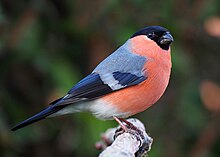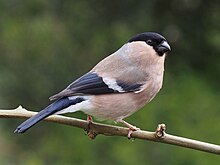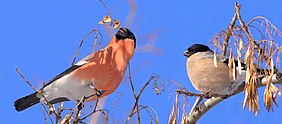| Eurasian bullfinch | |
|---|---|

| |
| Male in Lancashire, UK | |

| |
| Female in Lancashire, UK | |
| Conservation status | |
 Least Concern (IUCN 3.1) | |
| Scientific classification | |
| Domain: | Eukaryota |
| Kingdom: | Animalia |
| Phylum: | Chordata |
| Class: | Aves |
| Order: | Passeriformes |
| Family: | Fringillidae |
| Subfamily: | Carduelinae |
| Genus: | Pyrrhula |
| Species: | P. pyrrhula |
| Binomial name | |
| Pyrrhula pyrrhula (Linnaeus, 1758) | |

| |
| Range of P. pyrrhula Breeding Resident Non-breeding | |
| Synonyms | |
|
Loxia pyrrhula Linnaeus, 1758 | |
The Eurasian bullfinch, common bullfinch or bullfinch (Pyrrhula pyrrhula) is a small passerine bird in the finch family, Fringillidae. In Anglophone Europe it is known simply as the bullfinch (English regional, Shropshire: plum bird), as it is the original bird to bear the name bullfinch.
Taxonomy and systematics
The Eurasian bullfinch was formally described in 1758 by Linnaeus in the 10th edition of his Systema Naturae under the binomial name Loxia pyrrhula. It is now placed in the genus Pyrrhula that was introduced in 1760 by the French zoologist Mathurin Jacques Brisson. The Latin word pyrrhula comes from the Greek πυρρός (a flame-coloured bird, from πυρρός 'flame-coloured', from πυρ 'fire': Pyrrha), a 'worm eating bird' that is mentioned by Aristotle. The Latin name pyrrhula for the Eurasian bullfinch had been used in 1555 by the Swiss naturalist Conrad Gessner in his Historiae animalium.
Subspecies
Ten subspecies are recognised:
- P. p. pileata MacGillivray, W, 1837 – British Isles
- P. p. pyrrhula (Linnaeus, 1758) – north, south central and east Europe across to central Siberia
- P. p. europaea Vieillot, 1816 – Western Europe
- P. p. iberiae Voous, 1951 – southwest France, northern Iberian Peninsula
- P. p. rossikowi Derjugin & Bianchi, 1900 – northeast Turkey and the Caucasus
- P. p. cineracea Cabanis, 1872 (Baikal bullfinch) – west Siberia and northeast Kazakhstan to east Siberia and northeast China
- P. p. caspica Witherby, 1908 – Azerbaijan and north Iran
- P. p. cassinii Baird, SF, 1869 – east Siberia
- P. p. griseiventris Lafresnaye, 1841 (Grey-bellied bullfinch) – Kuril Islands and north Japan
- P. p. rosacea Seebohm, 1882 – Sakhalin (island north of Japan)
The Azores bullfinch (P. murina), previously regarded as a subspecies of the Eurasian bullfinch, is now recognised as a separate species.
Description
The Eurasian bullfinch is a bulky bull-headed bird. The upper parts are grey; the flight feathers and short thick bill are black; as are the cap and face in adults (they are greyish-brown in juveniles), and the white rump and wing bars are striking in flight. The adult male has red underparts, but females and young birds have grey-buff underparts. It moults between July and October, but males do not have the duller autumn plumage that is typical of some other finches. The song of this unobtrusive bird contains fluted whistles, and is often described as "mournful". This Bullfinch's usual call is a quiet, low, melancholy whistled peeu or pew. The song is audible only at close range. It is a weak, scratchy warbling, alternating with soft whistles. Tamed bullfinches can be taught to repeat specific melodies.
Distribution and habitat
This bird breeds across Europe and temperate Asia. It is mainly resident, but many northern birds migrate further south in the winter. Mixed woodland with some conifers is favoured for breeding, including parkland and gardens.
Behaviour and ecology
This species does not form large flocks outside the breeding season, and is usually seen as a pair or family group.
Breeding
It builds its nest in a bush, (preferably more than four metres tall and wide), mature stands of scrub, or tree, laying four to seven pale blue eggs which are mottled with red-brown. It is peculiar among the Passeriformes for having spermatozoa with a rounded head and a blunt acrosome. This species produces two or three broods per season, from early May to mid-July. Nesting success increases progressively from April–May to June–July and August.
Food and feeding





The food is mainly seeds and buds of fruit trees, which can make it a pest in orchards: in England, for centuries every parish paid a bounty for every Eurasian bullfinch killed. Ash and hawthorn are favoured in autumn and early winter. If wild bird cover is planted for it, kale, quinoa and millet are preferred, next to tall hedges or woodland.
References
- BirdLife International (2018). "Pyrrhula pyrrhula". IUCN Red List of Threatened Species. 2018: e.T22720671A132141969. doi:10.2305/IUCN.UK.2018-2.RLTS.T22720671A132141969.en. Retrieved 19 November 2021.
- Paynter, Raymond A. Jnr., ed. (1968). Check-list of birds of the world, Volume 14. Vol. 14. Cambridge, Massachusetts: Museum of Comparative Zoology. p. 296.
- Linnaeus, C. (1758). Systema Naturæ per regna tria naturae, secundum classes, ordines, genera, species, cum characteribus, differentiis, synonymis, locis, Volume 1 (in Latin). Vol. v.1 (10th ed.). Holmiae:Laurentii Salvii. pp. 171–172.
- Brissons, M.J. (1760). Ornithologie, Volume 1. Vol. 1. Paris: Chez C.J.-B. Bauche. p. 36.
- ^ Gill, Frank; Donsker, David; Rasmussen, Pamela, eds. (January 2021). "Finches, euphonias". IOC World Bird List Version 11.1. International Ornithologists' Union. Retrieved 10 July 2021.
- Jobling, James A. (2010). The Helm Dictionary of Scientific Bird Names. London: Christopher Helm. p. 327. ISBN 978-1-4081-2501-4.
- Gesner, Conrad (1555). Historiæ animalium liber III qui est de auium natura. Adiecti sunt ab initio indices alphabetici decem super nominibus auium in totidem linguis diuersis: & ante illos enumeratio auium eo ordiné quo in hoc volumine continentur (in Latin). Zurich: Froschauer. pp. 701–702.
- Sangster, G.; et al. (2011). "Taxonomic recommendations for British birds: seventh report". Ibis. 153 (4): 883–892. doi:10.1111/j.1474-919X.2011.01155.x.
- RSPB Handbook of British Birds (2014). ISBN 978-1-4729-0647-2.
- Springer. "Songbirds turn on and tune up: Bullfinches have the brain power to learn to sing human melodies accurately". phys.org. Retrieved 2022-04-16.
- Birkhead, Timothy R.; Immler, Simone; Pellatt, E. Jayne; Freckleton, Robert (2006). "Unusual sperm morphology in the Eurasian Bullfinch (Pyrrhula pyrrhula)". Auk. 123 (2): 383–392. doi:10.1642/0004-8038(2006)123[383:USMITE]2.0.CO;2. S2CID 85709337.
- Hernández, Ángel (2020-10-17). "Breeding ecology of Eurasian bullfinches Pyrrhula pyrrhula in an Iberian hedgerow habitat". Journal of Natural History. 54 (39–40): 2613–2645. doi:10.1080/00222933.2020.1860263. ISSN 0022-2933.
- Dyda J, Symes N and Lamacraft D (2009) Woodland management for birds: a guide to managing woodland for priority birds in Wales. The RSPB, Sandy and Forestry Commission Wales, Aberystwyth, ISBN 978-1-905601-15-8
External links
- Audio recording from Xeno-canto
- Ageing and sexing by Javier Blasco-Zumeta & Gerd-Michael Heinze
- Feathers of Eurasian Bullfinch (Pyrrhula pyrrhula) Archived 2014-07-27 at the Wayback Machine
- Eurasian Bullfinches Pyrrhula pyrrhula and the ninebark fruits - video
- Bullfinches Pyrrhula pyrrhula - Less and less fruit means more and more work - video